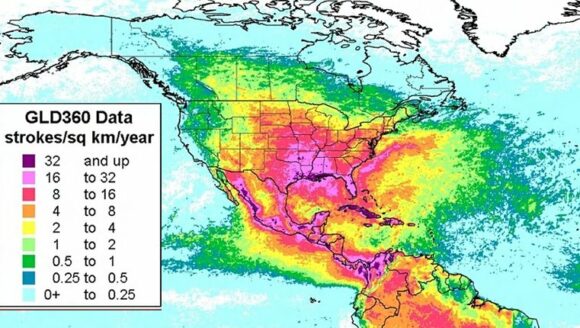Last year, three Mexico City climate researchers published a comprehensive study of the 7300+ deaths due to lightning in Mexico during the period 1979 to 2011.
In “Deaths by Lightning in Mexico (1979–2011): Threat or Vulnerability?“, G. B. Raga, M. G. de la Parra and Beata Kucienska examined the distribution of fatalities due to lighting, looking for links to population density, vulnerability and other factors.
The number of deaths from lightning averaged 230 a year for the period studied. Given Mexico’s population, this means a rate of 2.72 fatalities from lightning for every million people. This is the highest rate in the Americas.
Fatalities were not distributed evenly. Seven of Mexico’s 32 states accounted for 60% of all lightning fatalities. Almost one-quarter of all deaths from lightning occurred in the State of México. Other states with high rates included Michoacán, Oaxaca and Guanajuato.
More than 45% of all deaths from lightning were young males under the age of 25 (with those aged 10 to 19 at particular risk). Overall, far fewer females died from lightning than males, though for females, too, the highest rates were for the under-25 age group.
Most deaths happened in the first half of the rainy season, between June and August, when thunderstorms are most likely.
What do all these numbers mean?
The incidence of lightning strikes in not equal across the country. For example, in the period 2012-2014 (see map) there were far more lightning events in in central and southern Mexico than in the northern part of the country and the Baja California Peninsula. This means that there is no clear connection between deaths by lightning and population density. However, neither is there a clear connection between deaths by lightning and the places where most lightning strikes occur.
The key factor is not just how likely a lightning strike is to occur in a particular place but also how vulnerable the local populace is. Some sectors of the population are much more vulnerable than others. Those working outdoors, for example, are at higher risk than those working indoors. This makes rural workers more vulnerable than urban workers. It also makes younger people more vulnerable than older people.
Education and awareness also play a part. Many countries have seen a dramatic fall in deaths from lightning as a direct result of launching campaigns to make people more aware and provide education about safety precautions. In the USA, fewer than 40 people now die each year from lightning, compared to about 400 in the 1930s, when the population was smaller.
For this reason, the study also concluded that the large number of deaths in Mexico is partly due to “the government’s failure to implement education and prevention strategies in communities living and working in vulnerable conditions”. Sadly, this means that there will probably be further tragic incidents similar to the one that took the lives of several members of the same family last month in the remote mountainous community of Mesa Cuata in Guanajuato.
Reference:
G. B. Raga, M. G. de la Parra, and Beata Kucienska, 2014: “Deaths by Lightning in Mexico (1979–2011): Threat or Vulnerability?”. Weather, Climate & Society, 6, 434–444.
Related posts:
- Mexico’s January weather serves as a long-range forecast
- The link between climate change and migration from Mexico to the USA
- Mexico’s readiness to adapt to climate change and other global challenges
- The three main causes of precipitation in Mexico
- In which months are hurricanes most likely to strike Mexico?
- Severe hail storm hit central Mexico on 15 May 2011

Sorry, the comment form is closed at this time.